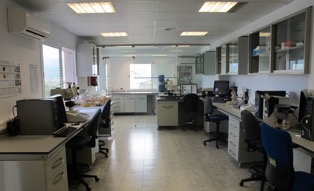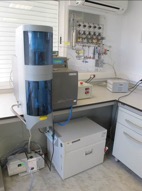

MaterLab
Durability and characterization of materials under concentrated solar radiation
This activity line of the laboratory is focused on the study and evaluation of how the concentrated solar radiation affects the performance and durability of materials. This is especially important for materials used for central receivers, thus requiring an accelerated ageing to study the durability of the most critical components of solar thermal power plants, not only absorbent materials, but also surface treatment and coatings that increase their absorptance. It is therefore necessary to find out and study the mechanisms of the physical degradation, fatigue and breakage of these materials at high temperatures under concentrated solar radiation.
The equipment associated to this activity is composed of devices located both indoor and outdoor. The indoor devices are devoted to the metallographic preparation and the analysis of test pieces treated with concentrated solar radiation and eventually thermal cycling for accelerated aging, and characterization of solar test by thermogravimetry. These devices are inside the Solar Furnaces control building and located in four rooms, every one of them dedicated to different kind of analyses:
- The Metallography Room
- The Microscopy Room
- The Thermogravimetry Room
- The Thermal Cycling Room
The lab’s equipment located in these rooms is listed below:
Metallography Room
- Automatic cut-off machine: Struers Secotom
- Manual cut-off machine: Remet TR60
- Mounting press: Struers Labopres-3
- Vacuum impregnation unit: Struers Epovac
- Polisher: Tegrapol-15 automatic with Tegradoser-5 dosing system
- Metallographic polisher 2 plates: LS1/LS2 (Remet)
- Grinder: Remet SM1000
- Ultrasonic bath: Selecta Ultrasons-H 75ºC with heater
- Fume cupboards: Flores Valles VA 120 960 M-010-02
- Power Source programmable: Iso-Tech IPS 405 for electrochemical attack
- Analytical sieve shaker: Retsch AS 200 Control (Sieves: 20, 10, 5, 2.5 y 1.25 mm and 710, 630, 425, 315, 250, 160, 150, 90, 53 y 32 µm)
- Digital Camera with reproduction table

Microscopy Room
- 3D Optical Surface Metrology System: Leica DCM 3D
- Leica DMI 5000 optical microscope with Leyca-IM50 image acquisition system and motorized table.
- Olympus optical microscope Union MC 85647.
- Struers micro hardness tester Duramin HMV-2 with visualization system and software micro Vickers hardness tester HMV-AD 3.12.
- Manual hardness tester
- Surface Finish Measuring Unit ZEISS Surfcom 480 with data processor
- Balance: Mettler E2001/MC max 60Kg
- Balance: Mettler Toledo classic max 320g / min 10mg
 (b)
(b) 
Thermogravimetry Room
- The thermogravimetric Balance SETSYS Evolution18 TGA, DTA, DSC (Temperature range ambient to 1750°C) equipped with a compact recirculating cooler (Julabo FC1600T) and a thermostatic line to 200°C, with a security box for tests in presence of H2, and adapted to connect a controlled evaporator mixer and a MicroGC simultaneously to the equipment. This thermogravimetic Balance has different possibilities of tests:
- Tests under pure Hydrogen atmosphere up to 1750°C
- Tests under pure Oxygen atmosphere
- Tests under H2O steam with other gases simultaneously.
- Tests under corrosive atmosphere up to 1000°C
- CEM System (Controled evaporator mixer system) for steam supply.
- Fixed Gas Detector: Dräger Polytron SE Ex, with a control system Regard 1.
Thermal Cycling Room
It includes the instrumentation necessary for thermal cycling:
- two muffle furnaces,
- a high-temperature kilns,
- a weathering chamber,
- an air-cooled volumetric receiver test loop and associated instrumentation;
- optical and electronic microscopes,
The indoor devices located in the four rooms described above are complemented by an electronic microscope installed in its own room, which is shared by the AMES and SCS units, and with the following specifications.
- Scanning electronic microscope (SEM) - Hitachi, model S-3400N II, high/low vacuum, secondary electron image, backscattered electron image, cooling stage and magnification 5x to 300.000x.
- Energy dispersive x-ray spectrometer (EDS) Quantax 400
Besides, the SEM room also has environmental secondary electron detector (ESED), a critical point dryer and sputterer.
The outdoor equipment is composed of several solar-dish concentrators located close to the PSA solar furnaces building. These solar dishes are used for thermal cycling under real solar conditions, with very high solar flux (up to 1200 kW/m2) and high temperatures (from 200°C to 1200°C) and are equipped with different test benches for volumetric and tube configuration testing.